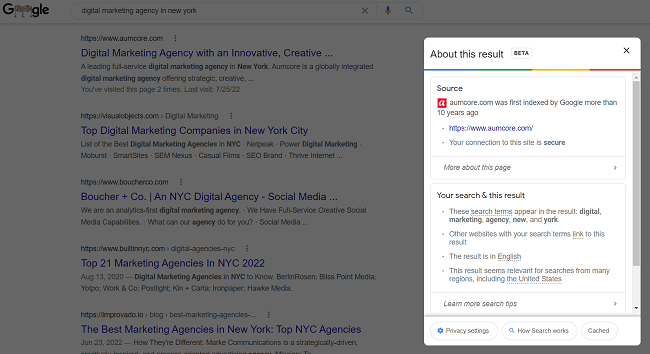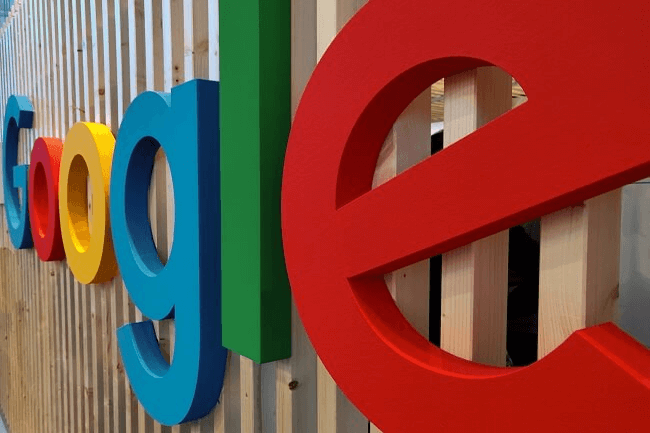Google has announced a new feature that makes it easy to understand what you are clicking on before you click on it. This new Google update ensures that the things we see online are from trusted sources.
Whether it’s the news we read, the pictures we see, or the videos we watch, unreliable information can have serious consequences. Before clicking on the search result, itself, users can now click on a widget that provides important information at a glance.
Many of us use search engines to find information, and this can lead us to coming across sources that may not be completely reliable. To this end, Google has begun introducing a new “About this result” feature to help users better understand the results returned by a search query. A search engine-friendly UX makes the world of difference when it comes to this feature.
So, what is the “About This Result” update?
To prevent the spread of misinformation, Google has also added an “About this result” section to their product offering. This means that each result provided by a search engine will have three dots (…). Clicking on it will display several options, including a section on this result, which will tell users where the information comes from and give them more details about their news sources.

The information in this section of the panel comes from Wikipedia. Of course, since not every page has a Wikipedia page, this does not apply to every link. In this case, the panel may show when the site was first indexed by Google.
Google also states that when searching for things like work or business listings, this resource section will provide more information about the nature of those results, not a description of a particular site. This makes more sense because these results can be drawn from a variety of sources.
What Else Does About This Result Panel Show?
The panel also displays the full URL of the link to give you a better idea of how it’s related to your search query. It should also tell you if the connection to the site is secure (in other words if it uses HTTPS).
In addition, part of the text declares that this is a search result, not a paid advertisement. This is increasingly necessary because a large portion of the results are above twice the number of currently paid ads – in fact, they are labeled “Ad” or “Sponsored” next to them – than organic search results.
Another link allows people to send feedback on the result, while “How to search” and “Privacy settings” appear at the bottom of the panel.
Currently, many search results for a particular topic are accompanied by a Knowledge Graph panel, which contains important information about that topic. This can include the date of birth of a topic, profiles on social networks, a related Wikipedia page, and related topics that are frequently searched, all to help people find specific information faster.
Although the About This panel uses information from Wikipedia, it is not intended to replace this Knowledge Graph. Instead, it gives users a better idea of the nature of the site where this information can be found, rather than more details about the topic itself.
Read More About: How Google’s SERP Design Is Impacting Organic Results
This feature is currently being introduced to desktops and mobile devices, as well as the Android version of the Google app.
How The “About This Result” Update Improves UX
Consider how the “About This” section looks similar to the Knowledge Graph or Google Information Box. But instead of specific topics, they share information on sites that deal with those topics. Allows users to:
- Check before visiting the site
- Get context to search for them
- Before clicking, decide if the information is useful
Note that Google will also launch a feature on this topic that will show the highest coverage of news as well as other search results that speak on the same topic. This is part of the search giant’s aim to help people:
- Avoid insulation inside the filter bubble
- Be exposed to and receive information from other trusted sites
The benefit of this is simply that users can easily access trusted sources with the least effort, reducing the risk of fake news and misinformation spreading.
How This Update Impacts Your Website
Your site needs to be ready for this update. What this means is that there are certain features that it should have to assist Google in promoting it.
These features include:
1. Keyword Matching
This version of the Google info field shows potential visitors the same keywords that appear in their search query. If your site appears in a SERP, it means that it used the same keywords in its query.
While this may sound simple, keep in mind how often Google updates search results and how it affects your search engine rankings. After the update, you may find that you’re falling in the rankings simply because Google finds other sites that provide more valuable information.
Search engine optimization (SEO) experts recommend keeping content up to date for the keywords you’re targeting. For example, when an article is written and published in 2020 about the leading SEO trends that increase search engine visibility, we can update it this year to reflect the changes that have taken place since then.
2. Relevant Conditions
Nowadays, it is possible to increase online visibility by optimizing for relevant keywords. For example, in “how to cook fish in the oven,” Google says it will also search for pages with related terms like “cook” and “recipe” to match a search query.
You can increase your ranking on Google by creating content that focuses on relevant concepts and adds more value to your readers. Or try using a long post by entering matching and related search terms.
3. Link Building
In addition to providing a description of the domain and ensuring that it has a secure domain, Link building is the process of acquiring hyperlinks from other websites to yours. A hyperlink is a way for users to navigate between pages on the Internet. Search engines use links to crawl the web. They will track links between individual pages of your website and track links between entire websites.
Acquiring links you haven’t requested is the purpose of SEO. It’s always something you should strive for and build for in the long run. You do this by working to make your website link-worthy, either through a great product or aspect of your service or by producing great content that other websites refer to.
4. Local SEO
If your business has multiple branches or only serves certain areas, you’ll need to optimize for local keywords like “near me.” If you have a local SEO strategy, you can target the right people because Google will highlight your content relevant to your area. The more people find value on your site and find that it is available in their city or state, the more you can increase your business’s search engine visibility.

Read More About: Google Analytics 4: A Guide For Marketers In The Cookieless Era
6 Tips to Improve Your Website Pages for “About This Result” Update
To help you make the most of this update, here are 6 tips and tricks to help you use “About This” more effectively. Some of them may be obvious, but others may not be so obvious. But the truth is, there is always something to learn!
1. Know how to search
The first step to becoming a Google search expert is to learn how it works. Understand what your audience is looking for and design your website and its content to meet that need.
2. Add additional parameters to the search
Google search can match your site to search terms by using additional parameters. Users can include these parameters by adding a word or phrase in double quotes.
3. Consider Advanced Search
In Google Search, the Advanced Search option gives users more control over their queries.
With advanced search, you can easily find websites that are only available in a specific language, pages from a specific domain, or documents written in the last month or year.
4. Describe what people are looking for
One way to ensure that your site is linked to results is to match terms. In addition to these terms or keywords, try to describe them in words to explain them to a friend. This will help improve searchability
5. Be specific in your information
When people search for something on Google, the details always come in handy. Therefore, you need to focus on including information that is specific to the potential search question.
6. Include different terms
Using the same search terms means you’re likely to get a broader set of results that may include what you’re looking for. However, while it’s good to be specific, you want to avoid going too high!
Boost Your SEO Rankings with “About This”
This feature aims to help users make a more informed decision when it comes to finding information. This means that your business needs to ensure that your website caters to this advanced search functionality to not only improve brand awareness but solidify your brand as an industry expert.





Tell us your thoughts in the comments